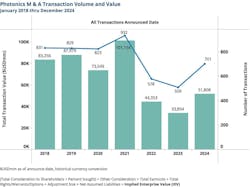Operating within an innovation-centric industry has its perks. The larger photonics industry is a prime example. For most of its existence, photonics companies have enjoyed the type of compounded annual growth rates (CAGRs) that lead to nice profits and further enable innovation efforts.
The past few years, however, have not been easy for many companies within this universe for a wide array of reasons, including political tensions leading to instability, a sluggish global slowdown of investments in new product designs, as well as a level of commoditization that routinely comes with market maturity.
In the rearview
While sluggish markets usually hit the smallest companies the hardest, a quick look at annual reports and public announcements reveals that some of the largest players also suffered—forcing most to make tough choices based off less-than-stellar performances.
The Trumpf Group recorded a decline in sales of 3.6% to 5.2 billion euros ($5.4B) at the close of the fiscal year 2023/24 on June 30, 2024 (2022/23 fiscal year: 5.4 billion euros). Their order intake fell for the second time in a row to 4.6 billion euros (fiscal 2022/23: 5.1 billion euros). This is 10.4% less than in the previous year. Operating earnings before interest and taxes (EBIT) fell by 114 million euros to 501 million euros as a result of the decline in sales compared to the previous year (615 million euros). The EBIT margin fell to 9.7% (previous year: 11.5%).
Similarly, IPG Photonics did not come out unscathed. According to its 2024 Q3 results, revenue decreased 23% year over year due to lower demand in industrial and e-mobility markets. Materials processing sales accounted for 89% of total revenue and decreased 22% year over year, primarily due to lower sales in cutting applications. Other sales decreased 28% year over year due to lower revenue in medical and advanced applications. Emerging growth products sales accounted for 45% of total revenue, a slight decrease from 46% in the prior quarter due to lower revenue for high-power pulsed lasers and medical products. By region, sales decreased 20% in North America, 27% in China, 29% in Europe, and 8% in Japan on a year-over-year basis.
Mergers & acquisitions activity
According to results presented by Linda Smith of Ceres Technical Advisors, the photonics mergers & acquisitions (M&A) market, like the broader global M&A landscape, endured a tumultuous three years, with activity and deal values well below the peak levels of 2020 and 2021.
Following record lows of 2023, M&A activity for photonics-related targets was on the rise, driven by strategic buyers seeking to navigate evolving markets, technological advancements, and the realities of government intervention. The absence of megamergers is attributed to several factors—high interest rates and increased cost of capital, regulatory scrutiny due to geopolitical tensions, and a shift to focus on core assets.
In 2024, larger photonics companies divested of businesses to realign with long-term growth objectives. Proceeds from these divestitures are often reinvested into core growth initiatives or used to reduce debt burdens. Additional motivations to divest include heightened regulatory scrutiny, driven by geopolitical and antitrust concerns, as well as challenges related to technology obsolescence and management bandwidth constraints.
Notably, Synopsys sold its Optical Solutions Group to Keysight Technologies to obtain regulatory approval for its proposed $35B acquisition of Ansys. And IPG Photonics sold its Russian subsidiary in a management buyout for $51M, finalizing its exit from Russia after Ukraine war trade sanctions were imposed.
2025 expectations
Looking ahead, analyst views differ with growth estimates ranging from 5% to 8% CAGR, but the photonics market as a whole is properly positioned to see growth, especially as it's key users including automotive, aerospace and defense, consumer device, healthcare, and communications regain momentum that remained stagnant in recent years. Which end of the anticipated range will depend heavily on whether or not the target industries are able to realize their own growth targets -- and to what extend they roll out photonics-based advances such as LiDAR.
Likewise, Element Six’s CTO Daniel Twitchen explains that as adoption of EUV lithography continues, the need for high-performance synthetic diamond optical windows increases. “With significant investment across both academia and the startup community, we expect to see diamond-enabled photonic quantum devices be considered for a wide range of applications—from healthcare to semiconductor device metrology,” he says. “With increased pressures in cost and throughput, a push for new high-power laser solutions is expected, leveraging both the optical and thermal benefits of synthetic diamond.”
The key takeaway: As the photonics market continues to sprawl and enable growth and innovation opportunities within a wide array of verticals, its growth potential should remain attractive.
About the Author
Peter Fretty
Market Leader, Digital Infrastructure
Peter Fretty began his role as the Market Leader, Digital Infrastructure in September 2024. He also serves as Group Editorial Director for Laser Focus World and Vision Systems Design, and previously served as Editor in Chief of Laser Focus World from October 2021 to June 2023. Prior to that, he was Technology Editor for IndustryWeek for two years.
As a highly experienced journalist, he has regularly covered advances in manufacturing, information technology, and software. He has written thousands of feature articles, cover stories, and white papers for an assortment of trade journals, business publications, and consumer magazines.


